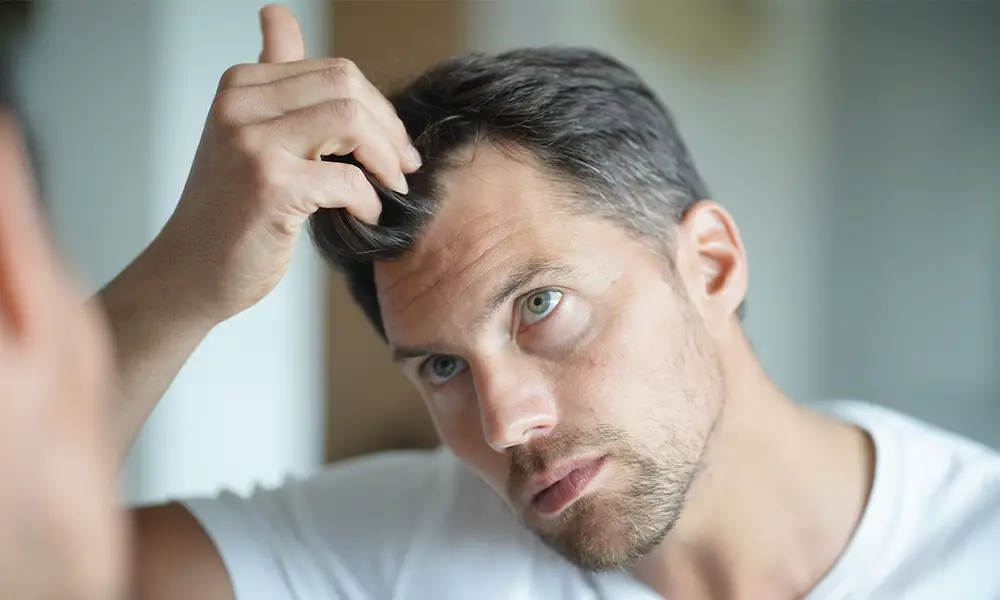Do you feel your hairline is receding and those luscious strips of hair thinning? You’re not alone, as these US hair loss statistics show us. Let’s look at the interesting world of hair loss:
US Hair Loss Statistics
- Permanent hair loss affects 70% of men in their lifetimes. (Wimpole Clinic)
- Permanent hair loss affects 40% of women in their lifetimes. (Wimpole Clinic)
- Approximately 35 million men and 21 million women suffer from hair loss in the US. (Statistic Brain Research Institute)
- Native Americans are immune to hair loss. (The Belgravia Centre)
- Searches for hair loss-related terms increased by 8% during the Covid lockdown. (Forbes)
- Hair loss can begin as early as in your teens, at 15 or 16. (Bosley)
- 3% of all pediatric office visits are caused by hair loss in children. (American Hair Loss Association)
- 58% of children suffering from alopecia also meet the criteria for anxiety disorders. (National Library of Medicine)
- The average person has 100,000 hair strands. (NHS)
- It is normal to shed up to 100 hairs daily. (National Library of Medicine)
- On average, hair grows between 0.2 and 0.7 inches per month. (Medical News Today)
- Roughly 90% of your hair is in the anagen phase (growth), with the remaining in the transition (catagen) or resting (telogen) phase.
- On average, hair grows between 0.2 and 0.7 inches per month. (Medical News Today)
- 47% of people would trade their life savings for a new, full head of hair. (The International Society of Hair Restoration Surgery)
Men’s Hair Loss Statistics
- By age 35, around two-thirds of men have lost a bit of hair. (The American Hair Loss Association)
- By 50, 85% of men have experienced hair thinning or lost a significant amount of hair. (The American Hair Loss Association)
- 95% of hair loss in men is caused by androgenic alopecia. (The American Hair Loss Association)
- 63 genes contribute to male pattern baldness. (Nature Communications)
- Men with the AR gene on the X chromosome are twice as likely to have male pattern baldness. (PLOS Genetics)
- Typically, it takes 15 to 25 years to go bald if you have male pattern baldness. (British Medical Journal)
- On average, male pattern baldness leads to 5% hair loss annually. (Clinical and Experimental Dermatology)
- Men of African descent have the lowest hair density, followed by Hispanics and Caucasians. (Journal of Skin Appendage Disorders)
- However, white men are more likely to develop androgenetic alopecia. (HWT Clinic)
- Men’s hair loss is most common in the Czech Republic (42.79%), followed by Spain (42.6%) and Germany (41.2%). (Daily Express)
- China has the lowest number of men suffering from hair loss. (Daily Express)
- 8% of non-balding men admit hair loss would affect them emotionally and 50% of men with mild hair loss are concerned about it. (Journal of the American Academy of Dermatology)
- 40% of men were unhappy with how their doctors dealt with the hair loss problem. (Journal of the European Academy of Dermatology and Venereology)
Women’s Hair Loss Statistics
- 2-3% of women are affected by female pattern hair loss by 30. (NHS)
- 30% of women are affected by female pattern hair loss by 70. (NHS)
- Four out of 10 women suffer from thinning hair during menopause. (The Hair Loss Doctors)
- African American women are more susceptible to hair loss. (The New York Times)
- One study found that 31.7% of women with relaxed or chemically straightened hair suffered from traction alopecia. (British Journal of Dermatology)
- 29% of women with hair loss also showed two symptoms of depression. (National Library of Medicine)
- Women with high-stress levels are 11 times more likely to experience hair loss. (National Library of Medicine)
- 43% of women wished their hair was fuller and thicker. (Statista)
- 81% of women feel confident when their hair looks great, with 72% saying their hair is empowering. (National Library of Medicine)
- 81% of women think hair thinning affects a woman’s appearance negatively. (Push Doctor)
Causes of Hair Loss
- Hair loss is both a genetic and epigenetic issue. (HWT Clinic)
- Exposing your hair to extreme heat or hairdressing techniques can lead to hair thinning. (Harvard Medical School)
- 65% of patients undergoing chemo experience hair loss. (National Library of Medicine)
- 425 out of 500 smokers show signs of hair loss, compared to just 200 out of 500 non-smokers. (Wiley Online Library)
- Approximately 40% to 50% of women suffer from postpartum hair loss. (The American Pregnancy Association)
- Riboflavin, biotin, folate, and vitamin B12 deficiencies have been associated with hair loss. (Dermatology and Therapy Journal)
- Baldness has been linked to coronary heart disease risk, especially if the baldness is on the top of the head. (Medical News Today)
Combatting Hair Loss
- 42 million Americans used hair growth products in 2020. (Statista)
- The number of Americans using hair products is expected to reach 12.94 million in 2024. (Statista)
- The hair loss treatment and removal market stood at $2.8 billion in 2022 in the US. (Ibis World)
- The hair loss treatment and removal market grew by 1.7% in 2022. (Ibis World).
- Between 2017 and 2022, the hair loss treatment market grew by 4.4%. (Ibis World)
- The global hair wig market is expected to reach $3 billion by 2028. (Fortune Business Insights)
- North America has the highest share of the worldwide hair wig market. (Fortune Business Insights)
- Over 50% of Americans wear or have worn some type of wig or hair extension. (Ultimate Looks)
- Hong Kong is the main exporter of a human hair (44.4%), followed by India (14.3%). (Statista)
- Minoxidil (Romaine) has been effective in encouraging hair growth in 60% of men. (Electronic Medicines Compendium)
- 87% had a positive result in terms of hair growth when using finasteride (Propecia). (Journal of Dermatology)
- There are two common hair transplant methods: follicular unit extraction (FUE) and follicular unit transplantation (FUT). (HWT Clinic)
- 85% of people who had hair transplant surgery were male, and the remaining 15% were female. (UK Smiles)
- One out of 13 men has a hair transplant. (Business Insider)
- FUE is used in 66.2% of hair transplant procedures and FUT in 31.5%, with 2.35% using both. (HWT Clinic)
- Hair transplant operations have increased by 60% since 2014. HWT Clinic)
- 37% of people who had hair transplant surgery did it to improve their social/dating lives, and 34.7% to have a better professional life/career. (ISHRS)
- Most hair transplant patients were 26-35-year-olds (45.2%), followed by 36-45-year-olds (42.2%). (UK Smiles)
- 2% of hair transplant patients achieved desired results with a single surgery. (ISHRS)
- 42% of patients had to have a second surgery. (ISHRS)
- Canada has the highest average hair transplant cost of $17,500. (Statista)


